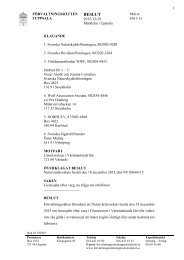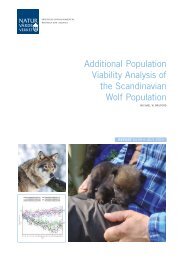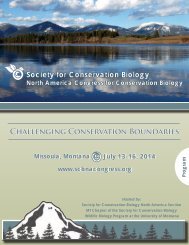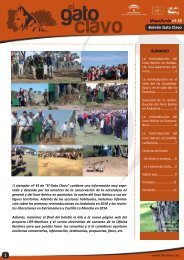1oC3Dbk
1oC3Dbk
1oC3Dbk
Create successful ePaper yourself
Turn your PDF publications into a flip-book with our unique Google optimized e-Paper software.
orn in the wild to captive reared parents. Decimated by leadpoisoning,<br />
the California condor’s return to the skies over the<br />
Pacific American seaboard is a remarkable tale of passionate<br />
people, dedication and hope. The excitement surrounding the<br />
discovery of these wild-born chicks was tempered in July with<br />
confirmation the third chick had not survived a rock fall which<br />
had smothered its nesting area. The incident served to remind<br />
us all that nature truly is a wild and unpredictable force, and<br />
one to be respected not least for its inimitable ways.<br />
Half a world away in Africa, Save the Rhino Trust Namibia had<br />
proudly reported 357 consecutive poaching free days in the<br />
Kunene region, thanks to a highly effective patrolling and<br />
monitoring programme whose roots run deep in the region’s<br />
conservancy system which actively involves community<br />
members in conservation initiatives. In July 2013, in Ishaqbini<br />
Province, north eastern Kenya, grantee Northern Rangelands<br />
Trust announced the birth of eight Hirola in a specially built<br />
sanctuary managed by local community members. The fact<br />
that all eight babies survived is an indication of the value of<br />
sanctuaries in securing a future for one of the most threatened<br />
antelopes in Africa, as well as benefiting the eco-tourism plans<br />
of communities in north eastern Kenya.<br />
>>Communications and Outreach<br />
In 2013 we increased our public engagement efforts by<br />
reaching out to supporters through social media and events as<br />
well as through our existing network of colleagues. As part of<br />
its strategy to attract new donors, SOS aims to communicate<br />
these positive messages about wildlife conservation beyond<br />
the conservation community.<br />
The first major development was the enhancement and<br />
expansion of the SOS website, launching a DONATE button as<br />
well as improving the user experience with an interactive map<br />
and making news content more “shareable” on the web. Also,<br />
in early 2013, SOS launched its social media presence,<br />
steadily building a community of supporters. In December we<br />
passed the 30,000 friends milestone on Facebook and<br />
approached 1,000 followers on Twitter.<br />
In June, SOS nature – a photographic exhibition and series of<br />
free public talks in the heart of Geneva – celebrated the<br />
charismatic power of nature and wildlife in an effort to raise<br />
awareness among the wider public. Taking place in La Cité du<br />
Temps on an island in the Rhone, SOS nature ran for one<br />
month, reaching several thousand visitors in that time.<br />
In August, SOS discovered the power of crowd-funding by<br />
helping to coordinate the iucn annual ‘Big Swim’ fundraising<br />
event. The annual swim across Lac Léman from France to<br />
Switzerland was a perfect fit to raise money for a project by<br />
SOS grantee, the Endangered Wildlife Trust, to improve<br />
protection measures for the Vulnerable Dugongs of Bazaruto<br />
Archipelago National Park, Mozambique. With just three weeks<br />
of fundraising activity, the team managed to raise $21,000 for<br />
this project.<br />
>>Growing the partnership<br />
In 2012, Fondation Segré joined the SOS partnership, selecting<br />
two projects to be supported under the Second Call for<br />
Proposals. Its decision to fund two more projects under the<br />
Third Call for Proposals issued in July 2013, was an encouraging<br />
sign that SOS can offer a valuable service to foundations<br />
looking for guidance on biodiversity funding decisions. SOS<br />
continues to target other foundations in this vein.<br />
SOS graciously received a bequest from Dr Susan Mainka<br />
upon her passing. Sue was Director of the IUCN Global<br />
Species Programme from 2000 to 2004 and was a passionate<br />
supporter of action-oriented initiatives like SOS. The team and<br />
in particular, Jean-Christophe Vié, who Sue had originally<br />
hired, were touched deeply by this generosity. Like all<br />
donations, this money will be channelled into projects to<br />
maximise impact.<br />
>>Summary<br />
SOS is delivering conservation successes. While our ultimate<br />
goal is to help protect threatened species, SOS must<br />
communicate and attempt to grow the partnership, inviting<br />
new donors to secure the necessary support that will fund<br />
more projects. SOS is a dynamic instrument in the IUCN<br />
toolkit that can help transform Red List knowledge into action<br />
on the ground and connect partners with the global<br />
conservation community. As such we continue to work to<br />
profile SOS and its grantees’ success stories, while improving<br />
SOS integration with relevant initiatives that have been<br />
implemented by our colleagues across IUCN and the Global<br />
Species Programme, especially.<br />
Mission to Kenya. © Michel Gunther<br />
Finally, SOS would like to express a big<br />
and warm thanks to SSC members<br />
who have contributed time and<br />
expertise to SOS as well as to our<br />
partners and donors. Truly, without all<br />
these individual efforts we really could<br />
not achieve so much. The challenge<br />
remains to attract new partners in<br />
order to fill the funding gap and<br />
support more projects, leveraging our<br />
combined talents, knowledge and<br />
expertise. Let us continue to do so.<br />
103






